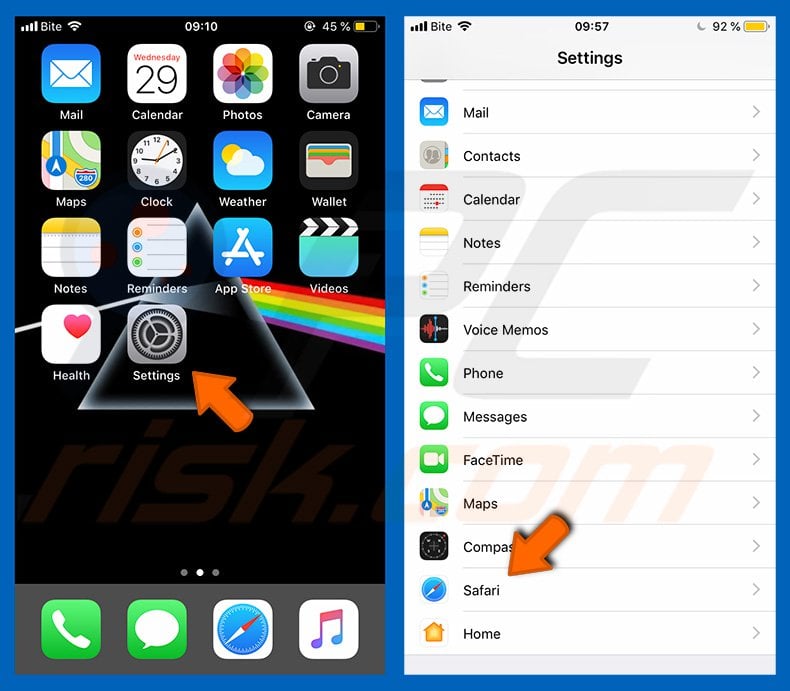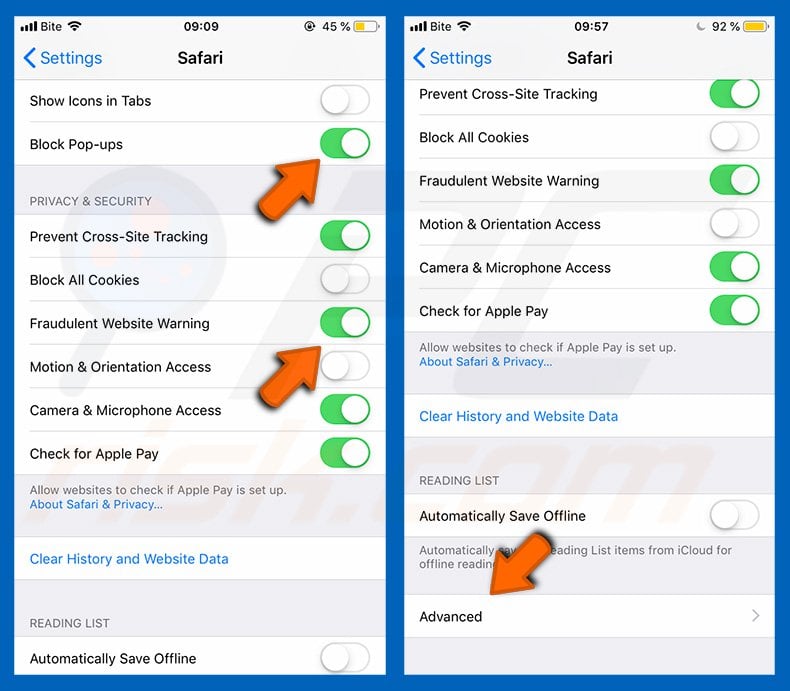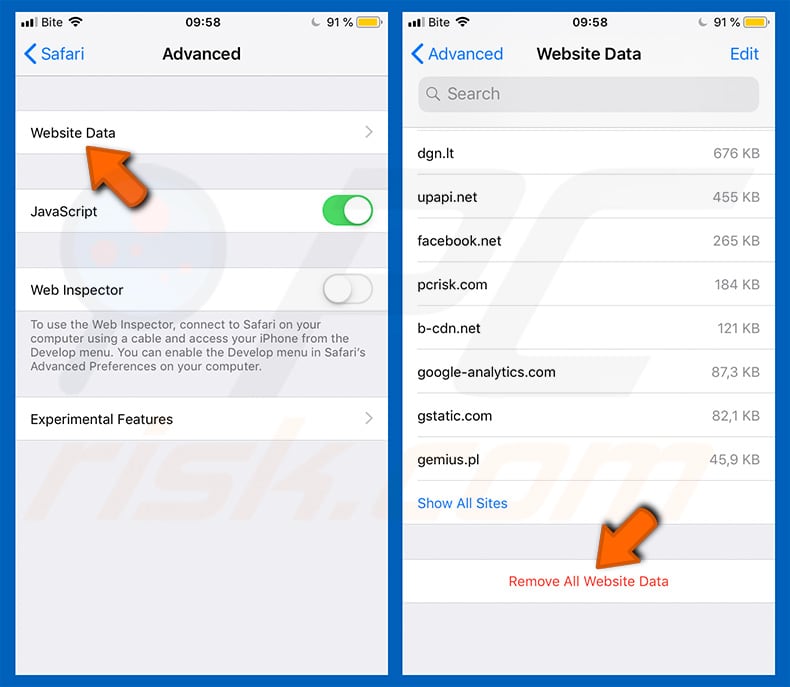Avoid being scammed by connection-protect.com
Mac VirusAlso Known As: connection-protect.com pop-up
Get free scan and check if your device is infected.
Remove it nowTo use full-featured product, you have to purchase a license for Combo Cleaner. Seven days free trial available. Combo Cleaner is owned and operated by RCS LT, the parent company of PCRisk.com.
What is connection-protect[.]com?
connection-protect[.]com is a deceptive website, which promotes various scams. It has been observed promoting schemes that target Apple product users, primarily mobile device users. At the time of research, the scam run on connection-protect[.]com claimed that visitors' devices may have been compromised due to recently visited, harmful web pages.
It makes these false claims to trick users into downloading/installing and/or purchasing untrusted software. Typically, sites such as connection-protect[.]com are accessed via redirects caused by intrusive ads or Potentially Unwanted Applications (PUAs) already infiltrated into the system.
![connection-protect[.]com scam](/images/stories/screenshots202008/connection-protect-com-scam-main.jpg)
The two scam variants promoted via connection-protect[.]com are practically identical, the main difference being that the supposedly compromised device is identified as an iPad or iPhone. Once accessed, connection-protect[.]com displays a pop-up window, which states that "suspicious activity" has been detected on websites that users have recently visited.
They are urged to close the notification and follow the instructions to secure their devices. After the pop-up is closed, users are presented with another window, which claims that visitors' iPads/iPhones may have been hacked. This security breach has allegedly occurred due to recently visited unsecured sites, which may have been phishing web pages.
According to the pop-up, if the issue is left unaddressed, it poses a risk to users' personal data and passwords. Therefore, if no action is taken, the fake alert threatens that the device may be blocked in order to secure it. To prevent this and secure their data, users are encouraged to install a "trusted cyber security application".
No website can detect threats or issues present on visitors' devices. Therefore, any that make such claims are scams, and connection-protect[.]com is no exception to this. Schemes of this type usually promote a wide variety of dubious products such as fake anti-virus tools, adware, browser hijackers and other PUAs.
The content obtained through these websites may be, or may contain, malicious software (e.g. Trojans, ransomware and other malware). In summary, trusting connection-protect[.]com (or similar pages) can lead to system infections, financial loss, serious privacy issues and even identity theft.
PUAs typically appear legitimate and offer a wide variety of "useful" functionalities, which are seldom operational. This is notable amongst fake anti-virus products that require activation (i.e. purchase) to perform the advertised features. Following activation, however, they remain nonoperational.
These unwanted apps also have dangerous capabilities. Some PUAs can force-open dubious and malicious websites. Adware-types deliver intrusive advertisements (e.g. pop-ups, banners, coupons, etc.). As well as diminishing the browsing experience, the delivered ads redirect to dangerous pages and some can even stealthily download/install rogue software.
Browser hijackers make modifications to browser settings and restrict/deny access to them to promote fake search engines. The promoted web searchers are rarely capable of providing unique results, and so they redirect to Yahoo, Bing, Google and other legitimate search engines.
Most PUAs (regardless of type) monitor users' browsing activity and collect sensitive data. Information of interest includes: browsing and search engine histories, IP addresses, geolocations and other personally identifiable details. The collected data is then shared with and/or sold to third parties (potentially, cyber criminals).
To ensure device integrity and user safety, it is crucial to remove all suspect applications and browser extensions/plug-ins without delay.
| Name | connection-protect.com pop-up |
| Serving IP Address | 99.84.248.114 |
| Threat Type | Phishing, Scam, Mac malware, Mac virus. |
| Fake Claim | Scam claims users' devices may have been hacked. |
| Promoted Unwanted Application | Various dubious applications. |
| Symptoms | Your Mac becomes slower than normal, you see unwanted pop-up ads, you are redirected to dubious websites. |
| Distribution methods | Deceptive pop-up ads, free software installers (bundling), fake Flash Player installers, torrent file downloads. |
| Damage | Internet browser tracking (potential privacy issues), display of unwanted ads, redirects to dubious websites, loss of private information. |
| Malware Removal (Windows) |
To eliminate possible malware infections, scan your computer with legitimate antivirus software. Our security researchers recommend using Combo Cleaner. Download Combo CleanerTo use full-featured product, you have to purchase a license for Combo Cleaner. 7 days free trial available. Combo Cleaner is owned and operated by RCS LT, the parent company of PCRisk.com. |
suprotok.xyz, apps-notification.com, ivpnconfig.com, driveandparkgame.com and extrasafe.xyz are some examples of other deceptive sites akin to connection-protect[.]com. The internet is rife with various scams. Popular scam models include (but are not limited to) alerts that the device is at risk, notifications of outdated essential software, prize raffles, "unbelievable deals", etc.
Online schemes promote dubious/malicious software, trick users into revealing personal information, extract payment for fake services, and so on. Regardless of how these scams operate, their purpose identical: to generate revenue for the designers.
How did potentially unwanted applications install on my computer?
Some PUAs have "official" download web pages, which are often promoted by deceptive/scam sites. These apps are also distributed via download/installation set-ups of other products. This deceptive marketing technique of pre-packing regular software with unwanted or malicious additions is termed "bundling".
Rushing download/installation processes (e.g. skipping steps and sections, etc.) increases the risk of inadvertent installation of bundled content. Intrusive advertisements proliferate these applications as well. When clicked, the ads can execute scripts to download/install PUAs without users' consent.
How to avoid installation of potentially unwanted applications
You are advised to research all software before download/installation. All downloads must be done from official and verified sources. Untrusted download channels such as unofficial and free file-hosting sites, Peer-to-Peer sharing networks and other third party downloaders commonly offer deceptive and bundled content.
When downloading/installing, it is important to read the terms, explore all possible options, use the "Custom/Advanced" settings and opt-out of additional apps, tools, features, etc. If you encounter ads and/or redirects of this kind, inspect your devices and immediately remove all suspicious applications and browser extensions/plug-ins.
If your computer is already infected with PUAs, we recommend running a scan with Combo Cleaner Antivirus for Windows to automatically eliminate them.
Text presented in the pop-up window displayed by connection-protect[.]com scam website:
Attention!
There may be a suspicious activity on sites you visited. Close this notification and follow the instructions to protect your devices.
Second pop-up displayed by connection-protect[.]com:
![connection-protect[.]com scam displayed second pop-up](/images/stories/screenshots202008/connection-protect-com-scam-second-pop-up.jpg)
Text presented in this pop-up:
Your iPad may be hacked!
Due to recent visiting unsecured sites, personal data and passwords on this iPad might be stolen via phishing pages. Devices may be blocked today if no action is taken.
Install the most trusted cyber security application and protect your connection to protect your Apple ID credentials and your iCloud data from possible loss.
0 minute 00 second
Install Cancel
Advertisement
Mobile variant of the connection-protect[.]com scam website:
![connection-protect[.]com scam mobile variant](/images/stories/screenshots202008/connection-protect-com-scam-mobile-variant.jpg)
Text presented in this variant:
Your iPhone may be hacked!
Due to recent visiting unsecured sites, personal data and passwords on this iPhone might be stolen via phishing pages. Devices may be blocked today if no action is taken.
Install the most trusted cyber security application and protect your connection to protect your Apple ID credentials and your iCloud data from possible loss.
0 minute 00 second
Install Cancel
Advertisement
One of the dubious applications promoted by connection-protect[.]com scam website:
![connection-protect[.]com scam promoted PUA](/images/stories/screenshots202008/connection-protect-com-scam-promoted-pua.jpg)
To enable pop-up blocking, fraudulent website warnings, and remove web browsing data in mobile Apple devices, follow these steps:
First, go to "Settings", and then scroll down to find and tap "Safari".

Check if the "Block Pop-ups" and "Fraudulent Website Warning" toggles are enabled. If not, enable them immediately. Then, scroll down and tap "Advanced".

Tap "Website Data" and then "Remove All Website Data".

Instant automatic malware removal:
Manual threat removal might be a lengthy and complicated process that requires advanced IT skills. Combo Cleaner is a professional automatic malware removal tool that is recommended to get rid of malware. Download it by clicking the button below:
DOWNLOAD Combo CleanerBy downloading any software listed on this website you agree to our Privacy Policy and Terms of Use. To use full-featured product, you have to purchase a license for Combo Cleaner. 7 days free trial available. Combo Cleaner is owned and operated by RCS LT, the parent company of PCRisk.com.
Quick menu:
- What is "connection-protect[.]com"?
- STEP 1. Remove PUA related files and folders from OSX.
- STEP 2. Remove rogue extensions from Safari.
- STEP 3. Remove rogue add-ons from Google Chrome.
- STEP 4. Remove potentially unwanted plug-ins from Mozilla Firefox.
Video showing how to remove adware and browser hijackers from a Mac computer:
Potentially unwanted applications removal:
Remove potentially unwanted applications from your "Applications" folder:

Click the Finder icon. In the Finder window, select "Applications". In the applications folder, look for "MPlayerX","NicePlayer", or other suspicious applications and drag them to the Trash. After removing the potentially unwanted application(s) that cause online ads, scan your Mac for any remaining unwanted components.
DOWNLOAD remover for malware infections
Combo Cleaner checks if your computer is infected with malware. To use full-featured product, you have to purchase a license for Combo Cleaner. 7 days free trial available. Combo Cleaner is owned and operated by RCS LT, the parent company of PCRisk.com.
Remove adware-related files and folders

Click the Finder icon, from the menu bar. Choose Go, and click Go to Folder...
 Check for adware generated files in the /Library/LaunchAgents/ folder:
Check for adware generated files in the /Library/LaunchAgents/ folder:

In the Go to Folder... bar, type: /Library/LaunchAgents/

In the "LaunchAgents" folder, look for any recently-added suspicious files and move them to the Trash. Examples of files generated by adware - "installmac.AppRemoval.plist", "myppes.download.plist", "mykotlerino.ltvbit.plist", "kuklorest.update.plist", etc. Adware commonly installs several files with the exact same string.
 Check for adware generated files in the ~/Library/Application Support/ folder:
Check for adware generated files in the ~/Library/Application Support/ folder:

In the Go to Folder... bar, type: ~/Library/Application Support/

In the "Application Support" folder, look for any recently-added suspicious folders. For example, "MplayerX" or "NicePlayer", and move these folders to the Trash.
 Check for adware generated files in the ~/Library/LaunchAgents/ folder:
Check for adware generated files in the ~/Library/LaunchAgents/ folder:

In the Go to Folder... bar, type: ~/Library/LaunchAgents/

In the "LaunchAgents" folder, look for any recently-added suspicious files and move them to the Trash. Examples of files generated by adware - "installmac.AppRemoval.plist", "myppes.download.plist", "mykotlerino.ltvbit.plist", "kuklorest.update.plist", etc. Adware commonly installs several files with the exact same string.
 Check for adware generated files in the /Library/LaunchDaemons/ folder:
Check for adware generated files in the /Library/LaunchDaemons/ folder:

In the "Go to Folder..." bar, type: /Library/LaunchDaemons/

In the "LaunchDaemons" folder, look for recently-added suspicious files. For example "com.aoudad.net-preferences.plist", "com.myppes.net-preferences.plist", "com.kuklorest.net-preferences.plist", "com.avickUpd.plist", etc., and move them to the Trash.
 Scan your Mac with Combo Cleaner:
Scan your Mac with Combo Cleaner:
If you have followed all the steps correctly, your Mac should be clean of infections. To ensure your system is not infected, run a scan with Combo Cleaner Antivirus. Download it HERE. After downloading the file, double click combocleaner.dmg installer. In the opened window, drag and drop the Combo Cleaner icon on top of the Applications icon. Now open your launchpad and click on the Combo Cleaner icon. Wait until Combo Cleaner updates its virus definition database and click the "Start Combo Scan" button.

Combo Cleaner will scan your Mac for malware infections. If the antivirus scan displays "no threats found" - this means that you can continue with the removal guide; otherwise, it's recommended to remove any found infections before continuing.

After removing files and folders generated by the adware, continue to remove rogue extensions from your Internet browsers.
Remove malicious extensions from Internet browsers
 Remove malicious Safari extensions:
Remove malicious Safari extensions:

Open the Safari browser, from the menu bar, select "Safari" and click "Preferences...".

In the preferences window, select "Extensions" and look for any recently-installed suspicious extensions. When located, click the "Uninstall" button next to it/them. Note that you can safely uninstall all extensions from your Safari browser - none are crucial for regular browser operation.
- If you continue to have problems with browser redirects and unwanted advertisements - Reset Safari.
 Remove malicious extensions from Google Chrome:
Remove malicious extensions from Google Chrome:

Click the Chrome menu icon ![]() (at the top right corner of Google Chrome), select "More Tools" and click "Extensions". Locate all recently-installed suspicious extensions, select these entries and click "Remove".
(at the top right corner of Google Chrome), select "More Tools" and click "Extensions". Locate all recently-installed suspicious extensions, select these entries and click "Remove".

- If you continue to have problems with browser redirects and unwanted advertisements - Reset Google Chrome.
 Remove malicious extensions from Mozilla Firefox:
Remove malicious extensions from Mozilla Firefox:

Click the Firefox menu ![]() (at the top right corner of the main window) and select "Add-ons and themes". Click "Extensions", in the opened window locate all recently-installed suspicious extensions, click on the three dots and then click "Remove".
(at the top right corner of the main window) and select "Add-ons and themes". Click "Extensions", in the opened window locate all recently-installed suspicious extensions, click on the three dots and then click "Remove".

- If you continue to have problems with browser redirects and unwanted advertisements - Reset Mozilla Firefox.
Share:

Tomas Meskauskas
Expert security researcher, professional malware analyst
I am passionate about computer security and technology. I have an experience of over 10 years working in various companies related to computer technical issue solving and Internet security. I have been working as an author and editor for pcrisk.com since 2010. Follow me on Twitter and LinkedIn to stay informed about the latest online security threats.
PCrisk security portal is brought by a company RCS LT.
Joined forces of security researchers help educate computer users about the latest online security threats. More information about the company RCS LT.
Our malware removal guides are free. However, if you want to support us you can send us a donation.
DonatePCrisk security portal is brought by a company RCS LT.
Joined forces of security researchers help educate computer users about the latest online security threats. More information about the company RCS LT.
Our malware removal guides are free. However, if you want to support us you can send us a donation.
Donate
▼ Show Discussion